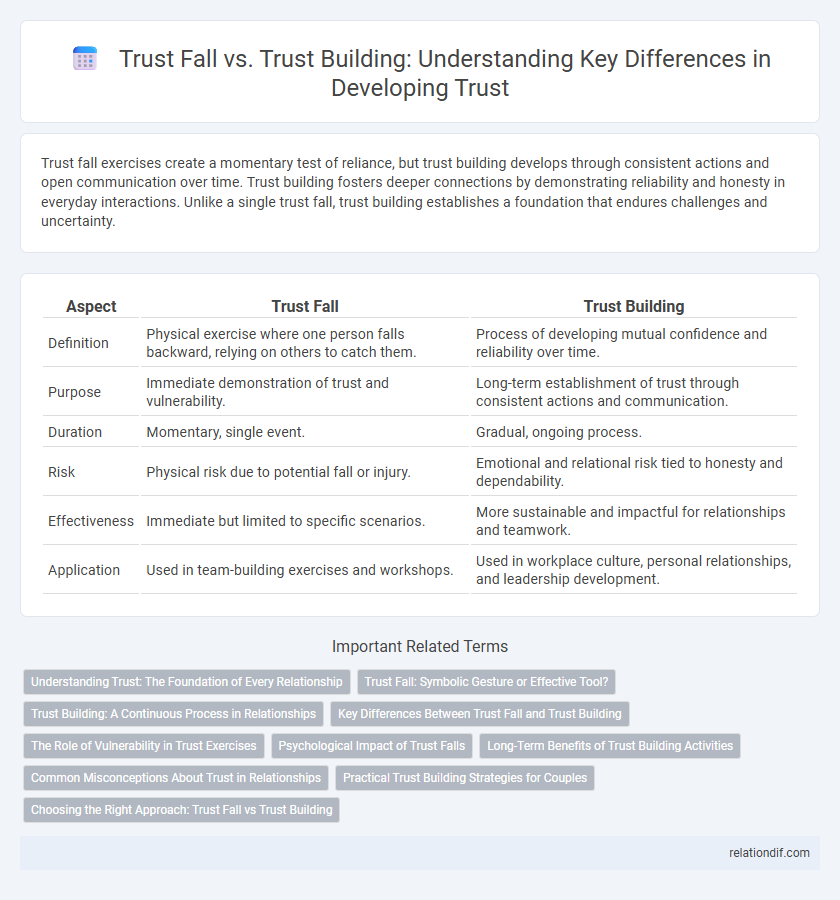Trust fall exercises create a momentary test of reliance, but trust building develops through consistent actions and open communication over time. Trust building fosters deeper connections by demonstrating reliability and honesty in everyday interactions. Unlike a single trust fall, trust building establishes a foundation that endures challenges and uncertainty.
Table of Comparison
| Aspect | Trust Fall | Trust Building |
|---|---|---|
| Definition | Physical exercise where one person falls backward, relying on others to catch them. | Process of developing mutual confidence and reliability over time. |
| Purpose | Immediate demonstration of trust and vulnerability. | Long-term establishment of trust through consistent actions and communication. |
| Duration | Momentary, single event. | Gradual, ongoing process. |
| Risk | Physical risk due to potential fall or injury. | Emotional and relational risk tied to honesty and dependability. |
| Effectiveness | Immediate but limited to specific scenarios. | More sustainable and impactful for relationships and teamwork. |
| Application | Used in team-building exercises and workshops. | Used in workplace culture, personal relationships, and leadership development. |
Understanding Trust: The Foundation of Every Relationship
Trust fall exercises highlight the importance of vulnerability and reliance in relationships, but true trust building extends beyond isolated moments to consistent actions that demonstrate reliability and empathy. Understanding trust involves recognizing its foundation as a dynamic process rooted in transparency, communication, and mutual respect. This ongoing commitment fosters deeper connections and strengthens the bonds that sustain every meaningful relationship.
Trust Fall: Symbolic Gesture or Effective Tool?
Trust fall exercises often serve as symbolic gestures intended to demonstrate vulnerability and promote trust among team members, yet their effectiveness varies widely depending on group dynamics and individual willingness. Studies highlight that trust building rooted in consistent communication and collaborative experiences tends to yield more sustainable trust than occasional trust fall activities. While trust falls can initiate awareness of dependence and support, they typically must be integrated within a broader trust-building framework to produce meaningful, long-term interpersonal trust.
Trust Building: A Continuous Process in Relationships
Trust building is a continuous process that requires consistent actions, transparency, and effective communication to strengthen relationships over time. Unlike a single trust fall exercise, genuine trust develops through repeated experiences that demonstrate reliability, honesty, and emotional support. This ongoing commitment fosters deeper connections and resilience in both personal and professional relationships.
Key Differences Between Trust Fall and Trust Building
Trust fall is a physical exercise designed to test individuals' willingness to rely on others in momentary situations, emphasizing immediate risk and vulnerability. Trust building, by contrast, involves a gradual process of developing confidence, transparency, and reliability over time through consistent actions and communication. The key difference lies in trust fall's short-term, high-risk demonstration versus trust building's long-term foundation for sustainable relationships.
The Role of Vulnerability in Trust Exercises
Vulnerability serves as the cornerstone in trust exercises, differentiating trust fall scenarios from gradual trust building processes. Trust falls rely on immediate physical surrender, demanding participants to expose their vulnerability in a single moment, whereas trust building emphasizes sustained openness and emotional risk-taking over time. This gradual revelation of vulnerability fosters deeper interpersonal connections and more resilient trust between individuals.
Psychological Impact of Trust Falls
Trust falls can create immediate emotional reactions such as anxiety and vulnerability, often leading to temporary increases in trust among participants. However, the psychological impact may include stress responses that hinder long-term trust development if not accompanied by consistent, supportive behavior. Sustainable trust building relies on repeated positive interactions and transparency, rather than isolated trust fall exercises.
Long-Term Benefits of Trust Building Activities
Trust building activities cultivate deep relationships through consistent communication, reliability, and empathy, leading to sustainable collaboration and increased productivity. Unlike the quick but transient impact of a trust fall exercise, trust building nurtures resilience and mutual respect over time. Organizations investing in trust building experience lower turnover rates and enhanced team cohesion, driving long-term success.
Common Misconceptions About Trust in Relationships
Trust Fall exercises are often mistaken as the ultimate method for building trust in relationships, but they primarily test physical reliance rather than emotional safety. True trust building requires consistent communication, vulnerability, and demonstrated reliability over time, which cannot be established through a single trust fall activity. Misunderstanding this distinction can lead to superficial trust without the deeper emotional connection essential for strong, lasting relationships.
Practical Trust Building Strategies for Couples
Effective trust building in couples involves consistent communication, active listening, and transparency to create a secure emotional environment. Practical strategies include setting clear expectations, practicing vulnerability without fear of judgment, and following through on commitments to reinforce reliability. Regularly expressing appreciation and addressing conflicts constructively further strengthens mutual trust and emotional intimacy.
Choosing the Right Approach: Trust Fall vs Trust Building
Choosing the right approach between trust fall exercises and trust building activities depends on the team's dynamics and long-term goals. Trust fall exercises create immediate, physical demonstrations of trust but may not foster deep, lasting relationships or consistent workplace trust. Trust building strategies, such as transparent communication and shared experiences, develop sustainable trust through ongoing positive interactions and mutual understanding.
Trust Fall vs Trust Building Infographic

 relationdif.com
relationdif.com